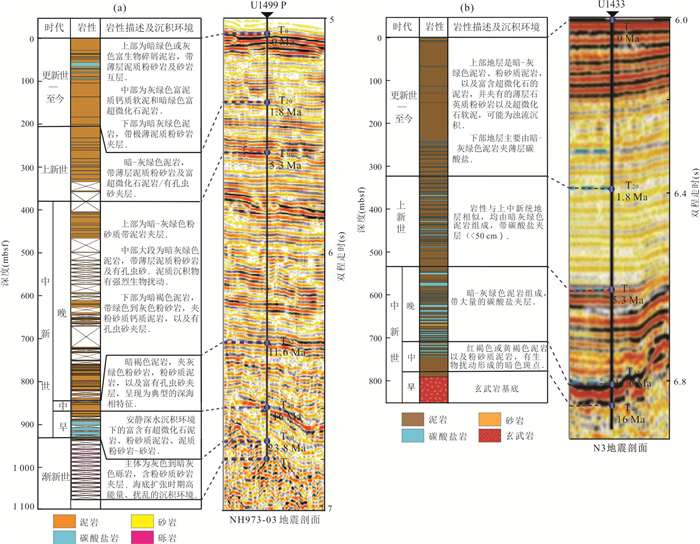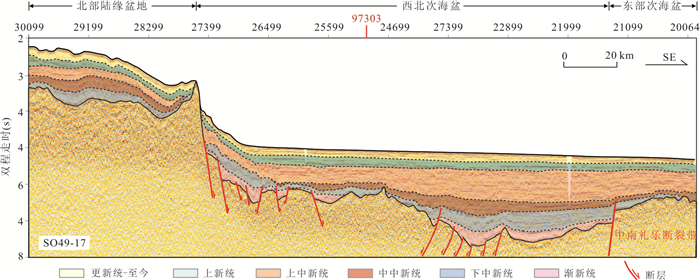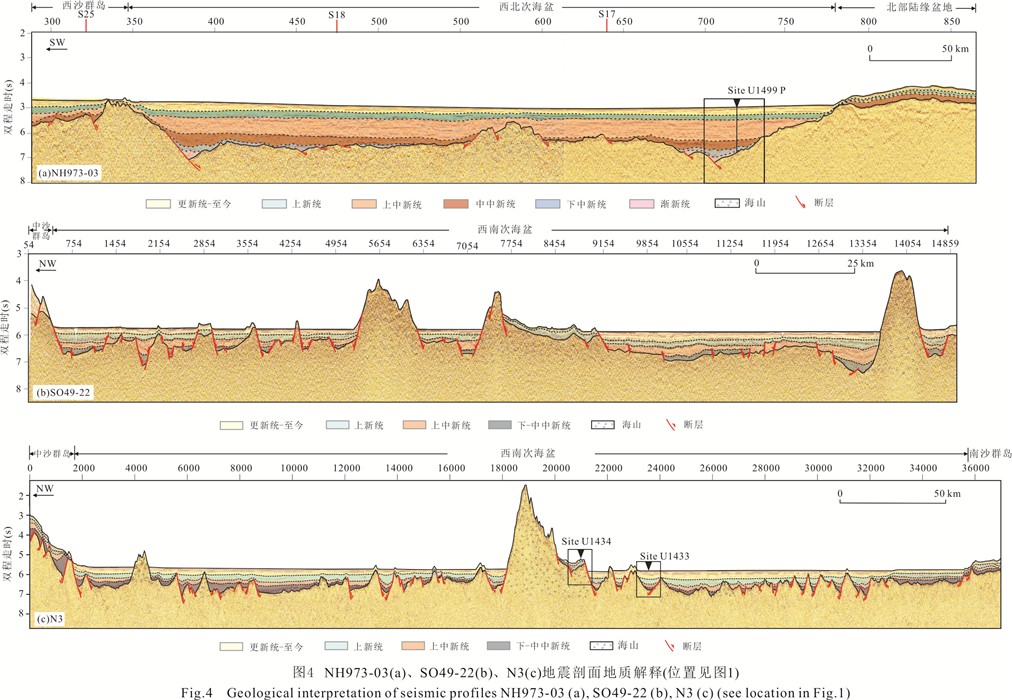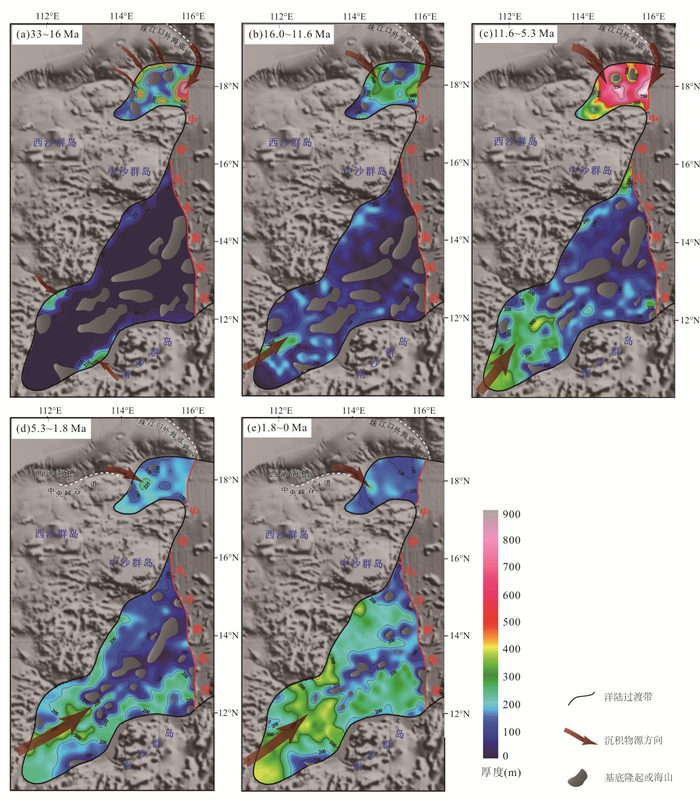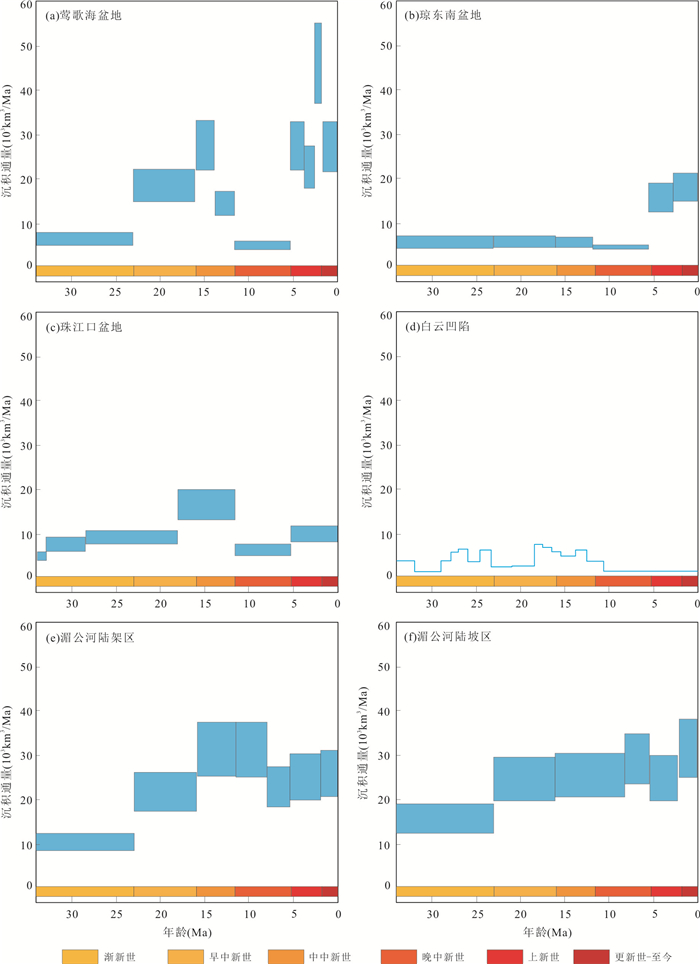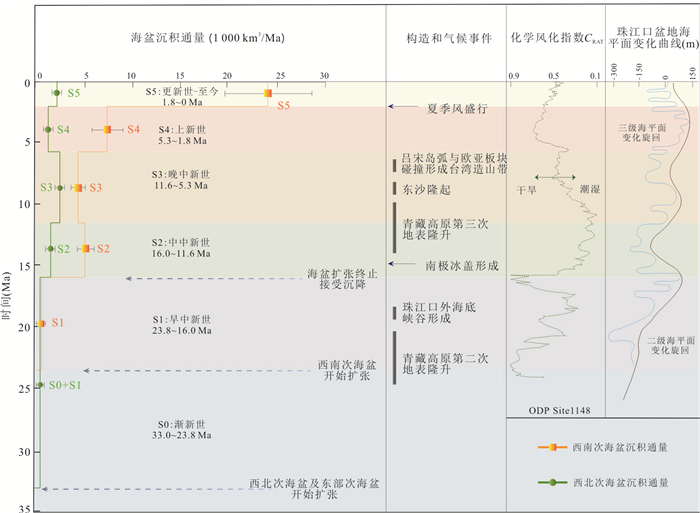Sedimentary Budget and Controlling Factors of the Northwest and Southwest Sub-Basins, the South China Sea
-
摘要: 作为西太平洋陆源沉积"源-汇"过程的重要场所,南海海盆半封闭的构造环境使得其与开放大洋的物质交换十分有限,沉积物保存基本完整,可以建立起南海沉积过程与区域重大构造事件、气候变化、海平面变化等之间的系统联系.选取南海西南与西北两个次海盆为对比研究区,基于穿越海盆的高分辨率多道地震测线和国际大洋发现计划(International Ocean Discovery Program,简称IODP)在南海获取的钻井数据,井震结合划分沉积单元,计算不同地质历史时期沉积通量,从而对海盆的沉积过程进行半定量化约束,并对控制因素和可能物源进行探讨.结果表明:南海西北次海盆和西南次海盆深海盆区的沉积过程整体上受到大型构造事件(青藏高原隆升-剥蚀作用)、东亚季风演化、陆缘水系(珠江、湄公河等)发展和相对海平面变化的控制,但在不同的区域会由于所处地理位置不同,以及局部构造事件影响而变得复杂化,从而使得西北次海盆与西南次海盆沉积通量在相同的地质时期呈现出不同的特征.西北次海盆沉积物主要源自华南大陆,并有少量来自红河、海南岛、北部陆架区局部隆起(如东沙隆起)的贡献.而西南次海盆的沉积物在晚中新世之前主要来自印支半岛、南沙地区和巴拉望,而在之后主要来自于现代湄公河.Abstract: South China Sea (SCS) is not only the crucial pathway for transporting terrigenous materials from Eurasia to the western Pacific Ocean since the Early Oligocene, but also the dominant accumulation and preservation place as a result of limited material exchange between the semi-closed oceanic basin and the open ocean since the Middle Miocene. Calculation of the sedimentary budget in different geological times is an important part in quantifying the sedimentary process in the SCS, which will not only construct the relationship between the sedimentary process of the SCS and the regional tectonic events, climate change, eustatic sea level change, etc, but also to improve our understanding on the "source-to-link" process of the West Pacific region. Based on multichannel seismic profiles across the northwest sub-basin (NWSB) and the southwest sub-basin (SWSB), combined with drilling results from IODP Expeditions, the sedimentary budget of the NWSB and SWSB has been calculated, and the controlling factors in different geological times have been discussed to reconstruct the Cenozoic sedimentary history. Efforts have been also made on the sedimentary provenance analysis. The sedimentary budget of the NWSB and the SWSB showed distinct characteristics in different geological times. Sedimentation is generally dominated by regional tectonic events (such as the uplift of the Tibet Plateau), monsoon, continental fluvial systems and sea-level changes, but will be complicated by local tectonic events and geographic position. The main sediment source of the NWSB was the terrestrial sediment transported from the South China, and a small amount from Red River, the Hainan Island, and Dongsha local uplifts. The sediment provenance of the SWSB was mainly from the Indo-China Peninsula, the Nansha area, and the Palawan before the Late Miocene. After that, sediments were mainly transported from the modern Mekong River.
-
图 1 南海主要构造单元及本次研究所用多道地震测线及IODP钻井分布
其中白色虚线方框内为研究区;右下角南海周缘陆上河流水系分布图据Liu et al.(2016)修改
Fig. 1. Main tectonic units and distribution of multichannel seismic profiles and IODP drilling sites in this study, South China Sea
图 2 U1499井(a)和U1433井(b)岩性、沉积环境及层序地层划分
U1499井岩性及地层年代据Li et al.(2015b);U1433井岩性柱及地层年代据Sun et al.(2018)
Fig. 2. Lithology, sedimentary enviroment of the sites U 1499 (a) and U 1433 (b), and the division of sedimentary units
图 6 南海陆缘主要沉积区沉积通量
a. 莺歌海‒宋红盆地(Clift and Sun, 2006);b.琼东南盆地(Clift and Sun, 2006);c.珠江口盆地(Clift, 2006);d.白云凹陷(Xie et al., 2013);e.湄公河陆架区(Clift,2006);f.湄公河陆坡区(Li et al., 2012)
Fig. 6. Sedimentary budgets of major sedimentary regions in the continental margin, South China Sea
图 7 南海西北次海盆和西南次海盆沉积通量变化及控制因素变化
化学风化指数CRAT函数据Clift et al.(2008);珠江口盆地相对海平面变化曲线据Pang et al.(2005)
Fig. 7. Sedimentary budget and controlling factors of the NWSB and SWSB
表 1 南海西南次海盆及西北次海盆沉积通量计算结果
Table 1. The calculation results of the sedimentary budget of the study area
沉积单元 地层 起止时间
(Ma)持续时间
(Ma)西北次海盆 西南次海盆 沉积物体积
(1 000 km3)沉积通量
(1 000 km3/Ma)沉积物体积
(1 000 km3)沉积通量
(1 000 km3/Ma)S5 更新统 1.8~0 1.8 4.30 2.39 43.46 24.14 S4 上新统 5.3~1.8 3.5 5.36 1.53 26.67 7.62 S3 上中新统 11.6~5.3 6.3 16.47 2.61 29.30 4.65 S2 中中新统 16.0~11.6 4.4 6.93 1.57 22.01 5.00 S1 下中新统 23~16 7 12.67 0.75 5.36 0.77 S0 渐新统 33~23 10 -
Briais, A., Patriat, P., Tapponnier, P., 1993. Updated Interpretation of Magnetic Anomalies and Seafloor Spreading Stages in the South China Sea: Implications for the Tertiary Tectonics of Southeast Asia. Journal of Geophysical Research: Solid Earth, 98(B4): 6299-6328. https://doi.org/10.1029/92jb02280 Cao, L. C., Shao, L., Qiao, P. J., et al., 2018. Early Miocene Birth of Modern Pearl River Recorded Low-Relief, High-Elevation Surface Formation of SE Tibetan Plateau. Earth and Planetary Science Letters, 496: 120-131. https://doi.org/10.1016/j.epsl.2018.05.039 Clark, M. K., Farley, K. A., Zheng, D. W., et al., 2010. Early Cenozoic Faulting of the Northern Tibetan Plateau Margin from Apatite (U-Th)/He Ages. Earth and Planetary Science Letters, 296(1-2): 78-88. https://doi.org/10.1016/j.epsl.2010.04.051 Clark, M. K., House, M. A., Royden, L. H., et al., 2005. Late Cenozoic Uplift of Southeastern Tibet. Geology, 33(6): 525-528. https://doi.org/10.1130/g21265.1 Clark, M. K., Schoenbohm, L. M., Royden, L. H., et al., 2004. Surface Uplift, Tectonics, and Erosion of Eastern Tibet from Large-Scale Drainage Patterns. Tectonics, 23(1): TC1006. https://doi.org/10.1029/2002tc001402 Clift, P. D., 2006. Controls on the Erosion of Cenozoic Asia and the Flux of Clastic Sediment to the Ocean. Earth and Planetary Science Letters, 241(3-4): 571-580. https://doi.org/10.1016/j.epsl.2005.11.028 Clift, P. D., Hodges, K. V., Heslop, D., et al., 2008. Correlation of Himalayan Exhumation Rates and Asian Monsoon Intensity. Nature Geoscience, 1(12): 875-880. https://doi.org/10.1038/ngeo351 Clift, P. D., Layne, G. D., Blusztajn, J., 2004. Marine Sedimentary Evidence for Monsoon Strengthening, Tibetan Uplift and Drainage Evolution in East Asia. In: Clift, P. D., Wang, P., Hayes, D., et al., eds., Continent-Ocean Interactions Within East Asian Marginal Seas. American Geophysical Union, Washington, D. C. . https://doi.org/10.1029/149gm14 Clift, P. D., Sun, Z., 2006. The Sedimentary and Tectonic Evolution of the Yinggehai-Song Hong Basin and the Southern Hainan Margin, South China Sea: Implications for Tibetan Uplift and Monsoon Intensification. Journal of Geophysical Research: Solid Earth, 111(B6): B06405. https://doi.org/10.1029/2005jb004048 Ding, W. W., Li, J. B., 2016. Propagated Rifting in the Southwest Sub-Basin, South China Sea: Insights from Analogue Modelling. Journal of Geodynamics, 100: 71-86. https://doi.org/10.1016/j.jog.2016.02.004 Ding, W. W., Li, J. B., Li, J., et al., 2013. Formation Process and Controlling Factors of the Pearl River Canyon in the South China Sea. Journal of Tropical Oceanography, 32(6): 63-72 (in Chinese with English abstract). http://www.sciencedirect.com/science/article/pii/S0264817213000986 Ding, W. W., Li, J. B., Li, J., et al., 2013. Morphotectonics and Evolutionary Controls on the Pearl River Canyon System, South China Sea. Marine Geophysical Research, 34(3-4): 221-238. https://doi.org/10.1007/s11001-013-9173-9 Einsels, G., 1992. Sedimentary Basin: Evolution, Facies and Sedimentary Budget. In: Vezzoli, G., ed., Erosion in the Western Alps (Dora Baltea Basin): 2. Quantifying Sediment Yield. Sedimentary Geology, 171: 247-259. http://www.sciencedirect.com/science/article/pii/S0037073801000616 Figueiredo, J., Hoorn, C., van der Ven, P., et al., 2009. Late Miocene Onset of the Amazon River and the Amazon Deep-Sea Fan: Evidence from the Fozdo Amazonas Basin. Geology, 37(7): 619-622. https://doi.org/10.1130/g25567a.1 Franke, D., Savva, D., Pubellier, M., et al., 2014. The Final Rifting Evolution in the South China Sea. Marine and Petroleum Geology, 58: 704-720. https://doi.org/10.1016/j.marpetgeo.2013.11.020 Gao, H. F., 2012. Seismic Facies' Characteristic of Turbidites and Sea Level Change in the Northwest Sub-Basin of South China Sea since Late Miocene. Journal of Tropical Oceanography, 31(3): 113-119 (in Chinese with English abstract). http://en.cnki.com.cn/Article_en/CJFDTOTAL-RDHY201203016.htm Gong, Z. S., Li, S. T., Xie, T. J., 1997. Continental Margin Basin Analysis and Hydrocarbon Accumulation of the Northern South China Sea. Science Press, Beijing (in Chinese). Guan, Y. X., Yang, S. X., Song, H. B., et al., 2016. Study of Deep Water Channels in SW South China Sea Based on Multi-Beam Bathymetric and Multi-Channel Reflection Seismic Data. Chinese Journal of Geophysics, 59(11): 4153-4161 (in Chinese with English abstract). http://en.cnki.com.cn/Article_en/CJFDTOTAL-DQWX201611018.htm Hapke, C. J., Lentz, E. E., Gayes, P. T., et al., 2010. A Review of Sediment Budget Imbalances along Fire Island, New York: Can Nearshore Geologic Framework and Patterns of Shoreline Change Explain the Deficit?. Journal of Coastal Research, 263(3): 510-522. https://doi.org/10.2112/08-1140.1 He, M., Zhong, G. F., Liu, X. F., et al., 2017. Rapid Post-Rift Tectonic Subsidence Events in the Pearl River Mouth Basin, Northern South China Sea Margin. Journal of Asian Earth Sciences, 147: 271-283. https://doi.org/10.1016/j.jseaes.2017.07.024 Hodges, K., 2006. Climate and the Evolution of Mountains. Scientific American, 295(2): 72-79. https://doi.org/10.1038/scientificamerican0806-72 Hough, B. G., Garzione, C. N., Wang, Z., et al., 2011. Stable Isotope Evidence for Topographic Growth and Basin Segmentation: Implications for the Evolution of the NE Tibetan Plateau. Geological Society of America Bulletin, 123(1-2): 168-185. https://doi.org/10.1130/b30090.1 Huang, W., 2004. Sediment Distributional Patterns and Evolution in the South China Sea since the Oligocene (Dissertation). Tongji University, Shanghai (in Chinese with English abstract). Huang, W., Wang, P. X., 2006. The Statistics of Sediment Mass in the South China Sea: Method and Result. Advances in Earth Science, 21(5): 465-473 (in Chinese with English abstract). doi: 10.1007/s11707-007-0012-7 Hutchison, C. S., 2004. Marginal Basin Evolution: The Southern South China Sea. Marine and Petroleum Geology, 21(9): 1129-1148. https://doi.org/10.1016/j.marpetgeo.2004.07.002 Jiang, H. C., Wan, S. M., Ma, X. L., et al., 2017. End-Member Modeling of the Grain-Size Record of SikouziFine Sediments in Ningxia (China) and Implications for Temperature Control of NeogeneEvolution of East Asian Winter Monsoon. PLOS ONE, 12(10): E0186153. https://doi.org/10.1371/journal.pone.0186153. Jonell, T. N., Clift, P. D., Hoang, L. V., et al., 2016. Controls on Erosion Patterns and Sediment Transport in a Monsoonal, Tectonically Quiescent Drainage, Song Gianh, Central Vietnam. Basin Research, 29(S1): 659-683. https://doi.org/10.1111/bre.12199 Koppers, A. A. P., 2014. On the 40Ar/39Ar Dating of Low-Potassium Ocean Crust Basalt from IODP Expedition 349, South China Sea. AGU, San Francisco. http://adsabs.harvard.edu/abs/2014AGUFM.T31E..03K Kuhlemann, J., Frisch, W., Székely, B., et al., 2002. Post-Collisional Sediment Budget History of the Alps: Tectonic Versus Climatic Control. International Journal of Earth Sciences, 91(5): 818-837. https://doi.org/10.1007/s00531-002-0266-y Lavier, L. L., Steckler, M. S., Brigaud, F., 2001. Climatic and Tectonic Control on the Cenozoic Evolution of the West African Margin. MarineGeology, 178(1-4): 63-80. https://doi.org/10.1016/s0025-3227(01)00175-x Lei, C., Ren, J. Y., Sternai, P., et al., 2015. Structure and Sediment Budget of Yinggehai-Song Hong Basin, South China Sea: Implications for Cenozoic Tectonics and River Basin Reorganization in Southeast Asia. Tectonophysics, 655: 177-190. https://doi.org/10.1016/j.tecto.2015.05.024 Lei, Z. Y., Zhang, L., Wang, L. Z., et al., 2020. Provenance Migration in the Beikang Basin of the Southern South China Sea during the Oligocene to the Mid-Miocene. Earth Science, 45(5): 1855-1864 (in Chinese with English abstract). doi: 10.1111/1755-6724.14399/pdf Li, C. F., Li, J. B., Ding, W. W., et al., 2015a. Seismic Stratigraphy of the Central South China Sea Basin and Implications for Neotectonics. Journal of Geophysical Research: Solid Earth, 120(3): 1377-1399. https://doi.org/10.1002/2014jb011686 Li, C. F., Lin, J., Kulhanek, D. K., et al., 2015b. Proceedings of the International Ocean Discovery Program, 349: South China Sea. Tectonics. International Ocean Discovery Program, College Station. Li, C. F., Song, T. R., 2012. Magnetic Recording of the Cenozoic Oceanic Crustal Accretion and Evolution of the South China Sea Basin. Chinese Science Bulletin, 57(24): 3165-3181. https://doi.org/10.1007/s11434-012-5063-9 Li, C. F., Xu, X., Lin, J., et al., 2014. Ages and Magnetic Structures of the South China Sea Constrained by Deep Tow Magnetic Surveys and IODP Expedition 349. Geochemistry, Geophysics, Geosystems, 15(12): 4958-4983. https://doi.org/10.1002/2014gc005567 Li, J. B., Ding, W. W., Wu, Z. Y., et al., 2012. The Propagation of Seafloor Spreading in the Southwestern Subbasin, South China Sea. Chinese Science Bulletin, 57(20): 1896-1905 (in Chinese). doi: 10.1360/csb2012-57-20-1896 Lin, C. S., Shi, H. S., Li, H., 2018. Sequence Architecture, Depositional Evolution and Controlling Processes of Continental Slope in Pearl River Mouth Basin, Northern South China Sea. Earth Science, 43(10): 3407-3422 (in Chinese with English abstract). http://en.cnki.com.cn/Article_en/CJFDTotal-DQKX201810007.htm Liu, C., Clift, P. D., Carter, A., et al., 2017b. Controls on Modern Erosion and the Development of the Pearl River Drainage in the Late Paleogene. Marine Geology, 394: 52-68. https://doi.org/10.1016/j.margeo.2017.07.011 Liu, C., Clift, P. D., Murray, R. W., et al., 2017a. Geochemical Evidence for Initiation of the Modern Mekong Delta in the Southwestern South China Sea after 8 Ma. Chemical Geology, 451: 38-54. https://doi.org/10.1016/j.chemgeo.2017.01.008 Liu, Z. F., Stattegger, K., 2014. South China Sea Fluvial Sediments: an Introduction. Journal of Asian Earth Sciences, 79: 507-508. https://doi.org/10.1016/j.jseaes.2013.11.003 Liu, Z. F., Zhao, Y. L., Colin, C., et al., 2016. Source-to-Sink Transport Processes of Fluvial Sediments in the South China Sea. Earth-Science Reviews, 153: 238-273. https://doi.org/10.1016/j.earscirev.2015.08.005 Luan, X. W., Zhang, L., Peng, X. C., 2012. DongshaErosive Channel on Northern South China Sea Shelf and Its Induced Kuroshio South China Sea Branch. Science China Earth Sciences, 55(1): 149-158. https://doi.org/10.1007/s11430-011-4322-y Lüdmann, T., Kin Wong, H., Wang, P. X., 2001. Plio-Quaternary Sedimentation Processes and Neotectonics of the Northern Continental Margin of the South China Sea. Marine Geology, 172(3-4): 331-358. https://doi.org/10.1016/s0025-3227(00)00129-8 Ma, L. F., Bao, J., Ying, H., et al., 2016. The Response of Sediment Flux of Jiuxi Basin in the Northern Boundary of Qilian to the Tectonic Uplift and Weathering-Denudation History. ActaSedimentologicaSinica, 34(1): 49-57 (in Chinese with English abstract). http://search.cnki.net/down/default.aspx?filename=CJXB201601004&dbcode=CJFD&year=2016&dflag=pdfdown Ma, X. L., Tian, J., 2015. East Asian Monsoon Evolution and Aridification of Northwest China Viewed from Land and Sea on the Tectonic-Orbital Time Scale since 15 Ma. Quaternary Sciences, 35(6): 1320-1330 (in Chinese with English abstract). McDermott, J. A., Whipple, K. X., Hodges, K. V., et al., 2013. Evidence for Plio-Pleistocene North-South Extension at the Southern Margin of the Tibetan Plateau, Nyalam Region. Tectonics, 32(3): 317-333. https://doi.org/10.1002/tect.20018 Milliman, J. D., Farnsworth, K. L., 2011. River Discharge to the Coastal Ocean: Runoff, Erosion, and Delivery to the Coastal Ocean. In: Milliman, J., Farnsworth, K., eds., River Discharge to the Coastal Ocean: A Global Synthesis. Cambridge University Press, Cambridge. Pang, X., Chen, C. M., Shi, H. S., et al., 2005. Response between Relative Sea-Level Change and the Pearl River Deep-Water Fan System in the South China Sea. Earth Science Frontiers, 12(3): 167-177 (in Chinese with English abstract). http://www.researchgate.net/publication/284776739_Response_between_relative_sea-level_change_and_the_Pearl_River_deep-water_fan_system_in_the_South_China_Sea Pang, X., Chen, C. M., Zhu, M., et al., 2009. Baiyun Movement: a Significant Tectonic Event on Oligocene/Miocene Boundary in the Northern South China Sea and Its Regional Implications. Journal of Earth Science, 20(1): 49-56. https://doi.org/10.1007/s12583-009-0005-4 Richardson, N. J., Densmore, A. L., Seward, D., et al., 2010. Did Incision of the Three Gorges Begin in the Eocene?. Geology, 38(6): 551-554. https://doi.org/10.1130/g30527.1 Shi, X. B., Kohn, B., Spencer, S., et al., 2011. Cenozoic Denudation History of Southern Hainan Island, South China Sea: Constraints from Low Temperature Thermochronology. Tectonophysics, 504(1-4): 100-115. https://doi.org/10.1016/j.tecto.2011.03.007 Su, M., Xie, X.N., Wang, Z.F., et al., 2013. Sedimentary Evolution of the Central Canyon System in Qiongdongnan Basin, Northern South China Sea. Acta Petrolei Sinica, 34(3): 467-478 (in Chinese with English abstract). http://en.cnki.com.cn/Article_en/CJFDTOTAL-SYXB201303008.htm Su, M., Zhang, C., Xie, X.N., et al., 2014. Controlling Factors on the Submarine Canyon System: A Case Study of the Central Canyon System in the Qiongdongnan Basin, Northern South China Sea. Science China Earth Sciences, 57(10): 2457-2468. https://doi.org/10.1007/s11430-014-4878-4 Sun, Q. L., Wu, S. G., Cartwright, J., et al., 2014. Neogene Igneous Intrusions in the Northern South China Sea: Evidence from High-Resolution Three Dimensional Seismic Data. Marine and Petroleum Geology, 54: 83-95. https://doi.org/10.1016/j.marpetgeo.2014.02.014 Sun, Z., Jian, Z., Stock, J. M., et al., 2018. In: Proceedings of the International Ocean Discovery Program, Vol. 367/368, South China Sea Rifted Margin. International Ocean Discovery Program, College Station. Sun, Z., Zhong, Z. H., Keep, M., et al., 2009. 3D Analogue Modeling of the South China Sea: A Discussion on Breakup Pattern. Journal of Asian Earth Sciences, 34(4): 544-556. https://doi.org/10.1016/j.jseaes.2008.09.002 Syvitski, J. P. M., Milliman, J. D., 2007. Geology, Geography, and Humans Battle for Dominance over the Delivery of Fluvial Sediment to the Coastal Ocean. The Journal of Geology, 115(1): 1-19. https://doi.org/10.1086/509246 Taylor, B., Hayes, D.E., 1980. The Tectonic Evolution of the South China Basin. In: Hayes, D. E. ed., The Tectonic and Geologic Evolution of Southeast Asian Seas and Islands: Part 1. AGU, Washington, D. C. . http://ci.nii.ac.jp/naid/10007428136 Taylor, B., Hayes, D.E., 1983. Origin and History of the South China Sea Basin. In: Hayes, D. E. ed., The Tectonic and Geologic Evolution of Southeast Asian Seas and Islands: Part 2. . AGU, Washington, D. C. . Wan, S. M., Li, A. C., Jan-Berend, W. S., et al., 2007. Grain-Size Records at ODP Site 1146 from the Northern South China Sea: Implications on the East Asian Monsoon Evolution since 20 Ma. Science in China (Series D), 37(6): 761-770 (in Chinese). Wang, P. X., 2019. New Insights into Marine Basin Opening. National Science Review, 6(5): 870. https://doi.org/10.1093/nsr/nwz099 Wang, P. X., Huang, C. Y., Lin, J., et al., 2019. The South China Sea is not a Mini-Atlantic: Plate-Edge Rifting vs Intra-Plate Rifting. National Science Review, 6(5): 902-913. https://doi.org/10.1093/nsr/nwz135 Wang, P. X., Li, Q. Y., 2009. The South China Sea: Paleoceanography and Sedimentology. Science Business Media B.V., Springer, New York. Wang, Y. J., Cheng, H., Edwards, R. L., et al., 2008. Millennial-and Orbital-Scale Changes in the East Asian Monsoon over the Past 224, 000 years. Nature, 451(7182): 1090-1093. https://doi.org/10.1038/nature06692 Xie, H., Zhou, D., Pang, X., et al., 2013. Cenozoic Sedimentary Evolution of Deepwater Sags in the Pearl River Mouth Basin, Northern South China Sea. Marine Geophysical Research, 34(3-4): 159-173. https://doi.org/10.1007/s11001-013-9183-7 Xu, Y. G., Wei, J. X., Qiu, H. N., et al., 2012. Opening and Evolution of the South China Sea Constrained by Studies on Volcanic Rocks: Preliminary Results and a Research Design. Chinese Science Bulletin, 57(24): 3150-3164. https://doi.org/10.1007/s11434-011-4921-1 Yan, Z. K., Li, Y., Dong, S. L., et al., 2010. The Sediment Flux of the Longmen Shan Foreland Basin during the Late Triassic Epoch and the Uplift and Denudation of the Orogenic Belt. Acta Sedimentologica Sinica, 28(1): 91-101 (in Chinese with English abstract). http://en.cnki.com.cn/Article_en/CJFDTOTAL-CJXB201001013.htm Yao, B. C., Zeng, W. J., Hayes, D. E., 1994. The Geological Memoir of South China Sea Surveyed Jointly by China & USA. China University of Geosciences Press, Wuhan (in Chinese). Yuan, D. Y., Ge, W. P., Chen, Z. W., et al., 2013. The Growth of Northeastern Tibet and Its Relevance to Large-Scale Continental Geodynamics: A Review of Recent Studies. Tectonics, 32(5): 1358-1370. https://doi.org/10.1002/tect.20081 Zachos, J., Pagani, M., Sloan, L., et al., 2001. Trends, Rhythms, and Aberrations in Global Climate 65 Ma to Present. Science, 292(5517): 686-693. https://doi.org/10.1126/science.1059412 Zhang, P.Z., Molnar, P., Downs, W. R, 2001. Increased Sedimentation Rates and Grain Sizes 2-4 Myr Ago due to the Influence of Climate Change on Erosion Rates. Nature, 410(6831): 891-897. https://doi.org/10.1038/35073504. Zhang, R., Murphy, M. A., Lapen, T. J., et al., 2011. Late Eocene Crustal Thickening Followed by Early-Late Oligocene Extention along the India-Asia Suture Zone: Evidence for Cyclicity in the Himalayan Orogen. Geosphere, 7(5): 1249-1268. doi: 10.1130/GES00643.1 Zhang, W. Y., Zhang, F. Y., Chen, R. H., et al., 2002. Constituents of Matter and Sedimentation Fluxes and Sedimentation Rates of Deep-Water Sedimentation during the Late Pleistocene in the South China Sea. Acta Sedimentologica Sinica, 20(4): 668-674 (in Chinese with English abstract). http://en.cnki.com.cn/Article_en/CJFDTOTAL-CJXB200204022.htm Zhao, Q. H., Wang, P. X., 1999. Progress in Quaternary Paleoceanography of the South China Sea: A Review. Quaternary Sciences, 19(6): 481-501 (in Chinese with English abstract). http://www.oalib.com/paper/1572438 Zhou, D., Sun, Z., Liao, J., et al., 2009. Filling History and Post-breakup Acceleration of Sedimentation in Baiyun Sag, DeepwaterNorthern South China Sea. Journal of Earth Science, 20(1): 160-171. https://doi.org/10.1007/s12583-009-0015-2 doi: 10.1007/s12583-009-0015-24 Zhu, J. J., Li, S. Z., Lu, J. A., et al., 2020. Scientific Implications and Preliminary Surveying Results of Geological and Physical Oceanography Environment in the Shenhu Area of the Northern South China Sea. Earth Science, 45(4): 1416-1426 (in Chinese with English abstract). Zhu, S., Yao, Y. J., Luo, W. D., et al., 2017. Geomorphologic Unit Partition, Characteristics and Genesis for Central and Western South China Sea. Acta Geoscientica Sinica, 38(6): 897-909 (in Chinese with English abstract). http://www.zhangqiaokeyan.com/academic-journal-cn_acta-geoscientica-sinica_thesis/0201253091296.html 丁巍伟, 李家彪, 李军, 等, 2013. 南海珠江口外海底峡谷形成的控制因素及过程. 热带海洋学报, 32(6): 63-72. https://www.cnki.com.cn/Article/CJFDTOTAL-RDHY201306010.htm 高红芳, 2012. 南海西北海盆晚中新世以来浊积体地震相特征及海平面变化. 热带海洋学报, 31(3): 113-119. https://www.cnki.com.cn/Article/CJFDTOTAL-RDHY201203016.htm 龚再升, 李思田, 谢泰俊, 等, 1997. 南海北部大陆边缘盆地分析与油气聚集. 北京: 科学出版社. 关永贤, 杨胜雄, 宋海斌, 等, 2016. 南海西南部深水水道的多波束地形与多道反射地震研究. 地球物理学报, 59(11): 4153-4161. doi: 10.6038/cjg20161118 黄维, 2004. 渐新世以来南海沉积物分布格局及其演变(博士学位论文). 上海: 同济大学. 黄维, 汪品先, 2006. 南海沉积物总量的统计: 方法与结果. 地球科学进展, 21(5): 465-473. doi: 10.3321/j.issn:1001-8166.2006.05.004 雷振宇, 张莉, 王龙樟, 等, 2020. 南海南部北康盆地晚渐新世-中中新世物源变化. 地球科学, 45(5): 1855-1864. doi: 10.3799/dqkx.2019.162 李家彪, 丁巍伟, 吴自银, 等, 2012. 南海西南海盆的渐进式扩张. 科学通报, 57(20): 1896-1905. https://www.cnki.com.cn/Article/CJFDTOTAL-KXTB201220008.htm 林畅松, 施和生, 李浩, 等, 2018. 南海北部珠江口盆地陆架边缘斜坡带层序结构和沉积演化及控制作用. 地球科学, 43(10): 3407-3422. doi: 10.3799/dqkx.2018.311 马丽芳, 鲍晶, 应红, 等, 2016. 祁连山北缘酒西盆地新生代沉积通量变化对周缘山体构造隆升-风化剥蚀历史的响应. 沉积学报, 34(1): 49-57. https://www.cnki.com.cn/Article/CJFDTOTAL-CJXB201601004.htm 马小林, 田军, 2015. 15 Ma以来海陆记录的轨道-构造尺度东亚季风的演化以及西北内陆的干旱化. 第四纪研究, 35(6): 1320-1330. https://www.cnki.com.cn/Article/CJFDTOTAL-JJYJ201412003.htm 庞雄, 陈长民, 施和生, 等, 2005. 相对海平面变化与南海珠江深水扇系统的响应. 地学前缘, 12(3): 167-177. doi: 10.3321/j.issn:1005-2321.2005.03.018 苏明, 解习农, 王振峰, 等, 2013. 南海北部琼东南盆地中央峡谷体系沉积演化. 石油学报, 34(3): 467-478. https://www.cnki.com.cn/Article/CJFDTOTAL-SYXB201303008.htm 万世明, 李安春, Jan-Berend W. S., 等, 2007. 南海北部ODP1146站粒度揭示的近20 Ma以来东亚季风演化. 中国科学(D辑), 37(6): 761-770. https://www.cnki.com.cn/Article/CJFDTOTAL-JDXK200706006.htm 颜照坤, 李勇, 董顺利, 等, 2010. 龙门山前陆盆地晚三叠世沉积通量与造山带的隆升和剥蚀. 沉积学报, 28(1): 91-101. https://www.cnki.com.cn/Article/CJFDTOTAL-CJXB201001013.htm 姚伯初, 曾维军, Hayes, D.E., 1994. 中美合作调研南海地质专报. 武汉: 中国地质大学出版社. 章伟艳, 张富元, 陈荣华, 等, 2002. 南海深水区晚更新世以来沉积速率、沉积通量与物质组成. 沉积学报, 20(4): 668-674. https://www.cnki.com.cn/Article/CJFDTOTAL-CJXB200204022.htm 赵泉鸿, 汪品先, 1999. 南海第四纪古海洋学研究进展. 第四纪研究, 19(6): 481-501. https://www.cnki.com.cn/Article/CJFDTOTAL-DSJJ199906000.htm 朱俊江, 李三忠, 陆敬安, 等, 2020. 南海北部神狐海域地质环境综合调查及科学意义. 地球科学, 45(4): 1416-1426. doi: 10.3799/dqkx.2019.109 祝嵩, 姚永坚, 罗伟东, 等, 2017. 南海中西部地貌单元划分及其特征和成因分析. 地球学报, 38(6): 897-909. https://www.cnki.com.cn/Article/CJFDTOTAL-DQXB201706006.htm -









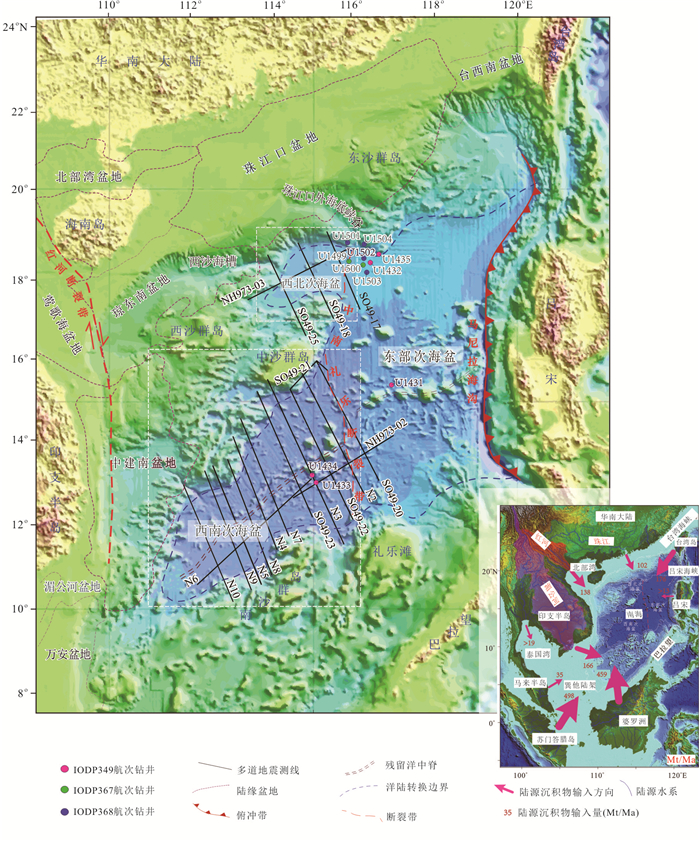
 下载:
下载:
